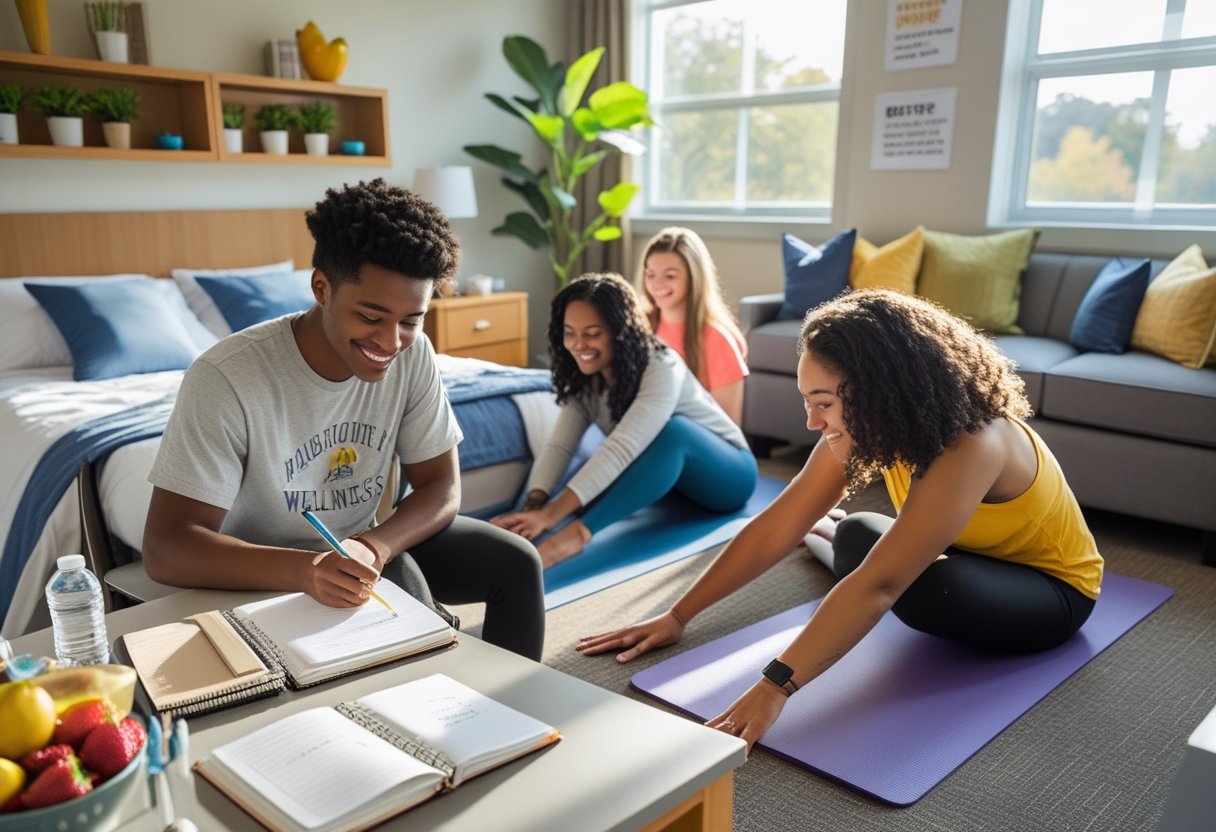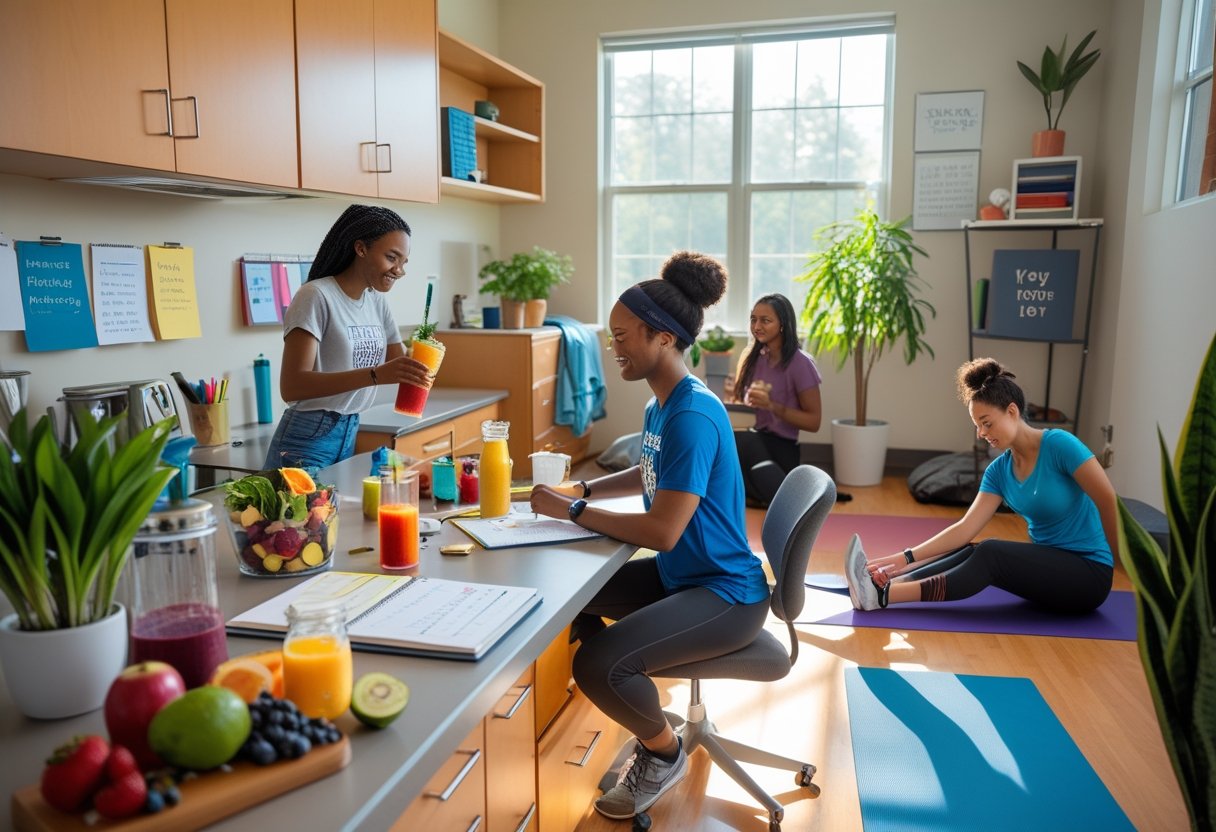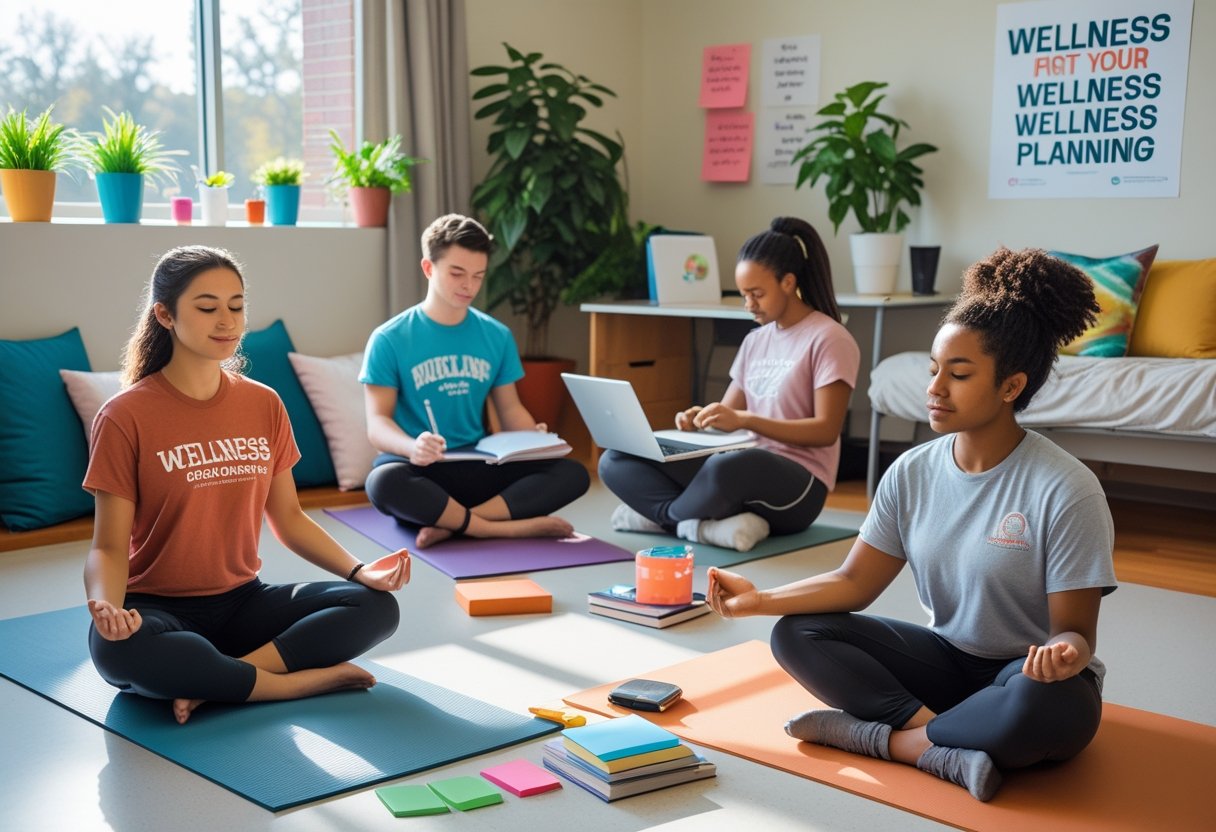Starting college brings major changes to a student’s daily routine, living situation, and responsibilities. Many first-year students struggle to balance academics, social life, and personal health during this transition period. Without proper planning, students often develop poor habits that can impact their success and well-being throughout their college years.

A personalized wellness plan helps first-year college students create sustainable habits for physical health, mental well-being, and academic success by addressing their individual needs and campus environment. The most effective wellness plans combine nutrition, exercise, stress management, and campus resources. Creating healthy habits during the first year sets the foundation for long-term success in college and beyond.
Students who develop personalized wellness strategies early in their college experience report better academic performance, stronger social connections, and improved overall health. The key lies in understanding that wellness plans must be customized to meet each individual student’s needs rather than following a one-size-fits-all approach.
Key Takeaways
- Personalized wellness plans help first-year students build sustainable habits that support their physical health, mental well-being, and academic success
- Effective wellness strategies combine proper nutrition, regular exercise, stress management techniques, and connection to campus resources
- Students who create individualized wellness plans early in college experience better academic performance and stronger social connections throughout their college years
Understanding the Importance of Wellness in College

College students face unique pressures that directly impact their mental, physical, and social health. 73% of college students experience mental health challenges, making wellness planning essential for academic success and personal growth.
Why Wellness Matters for First Year College Students
First year college students who prioritize wellness see measurable improvements in their academic performance. Students using proactive wellness strategies demonstrate 34% better academic performance outcomes.
The transition to college creates new stressors that affect learning ability. Students must manage coursework while adapting to independent living. Poor wellness habits lead to decreased focus, memory problems, and lower grades.
Key wellness benefits include:
- Better stress management during exams
- Improved sleep quality for enhanced learning
- Stronger immune system to avoid missing classes
- Higher energy levels for studying
Physical wellness directly connects to mental performance. Students who exercise regularly show improved concentration and reduced anxiety levels. Good nutrition supports brain function during demanding academic periods.
Social wellness helps students build support networks. Strong relationships provide emotional stability during challenging times. Students need strategies for strengthening connectedness, such as joining new groups.
Common Challenges Faced When Starting College
Starting college brings specific wellness challenges that can overwhelm new students. Typical adjustments include adapting to academic demands, acclimating to a new environment, and navigating new responsibilities.
Academic pressure creates the most immediate stress. Students face harder coursework and less structured schedules than high school. Time management becomes critical for maintaining balance.
Social isolation affects many first year students. They leave established friend groups and must build new relationships. Some students struggle with loneliness while adjusting to campus life.
Sleep disruption commonly occurs when students gain freedom over their schedules. Late night studying and social activities often interfere with healthy sleep patterns. Poor sleep affects mood, memory, and immune function.
Nutrition challenges emerge from dining hall options and irregular eating schedules. Weight gain in college is common given meal plans that offer all-you-can-eat and easy access to unhealthy food choices.
Financial stress impacts many students who manage budgets independently for the first time. Money concerns can affect food choices, healthcare access, and social activities.
The Holistic Approach to Student Well-Being
Universities recognize that effective wellness planning addresses multiple life areas simultaneously. Colleges are expanding traditional mental health services to include wellness as a prevention strategy for all students.
Physical wellness forms the foundation of holistic health. This includes regular exercise, proper nutrition, adequate sleep, and preventive healthcare. Students need consistent routines that support their body’s needs.
Mental wellness involves stress management, emotional regulation, and cognitive health. Students benefit from learning relaxation techniques and building resilience skills. Campus resources often provide tips for stress management and relaxation strategies.
Social wellness encompasses relationships, community involvement, and communication skills. Students should prioritize options that help build strong social networks.
Spiritual wellness includes personal values, purpose, and meaning. This might involve religious practices, meditation, or philosophical exploration.
The holistic approach recognizes that these areas interconnect. Problems in one area often affect others. Well-being is influenced by lots of factors, making personal wellness plans essential.
Building Healthy Habits for a Strong Start

Developing consistent routines, organizing time effectively, and setting up a positive living space create the foundation for college success. These core practices help students maintain their physical and mental health while managing academic demands.
Establishing a Consistent Daily Routine
Most college students need seven to nine hours of sleep each night, but 70 percent don’t get enough rest. Creating a sleep schedule starts with working backwards from wake-up time.
Students should count back at least seven hours to plan bedtime. They need to stop caffeine intake eight hours before sleep and avoid electronics one hour before bed.
Daily routine essentials include:
- Fixed wake-up and bedtime
- Regular meal times
- Study blocks
- Exercise periods
- Social time
Meal planning prevents poor food choices during busy days. Students should make eating a priority in their schedule since hungry brains can’t perform academically.
Each meal should include protein, fruits or vegetables, and grains. Campus dining halls offer unlimited portions, so students can return for more food when needed.
Time Management and Organization
Effective time management requires creating new habits that prevent overwhelm. Students need calendar systems with class days, times, locations, and important assignments.
Digital organization works well for most students. Google Drive or Microsoft 365 folders for each class keep materials accessible. Students should find note-taking methods that match their learning style.
Key organization strategies:
- Weekly schedule planning
- Assignment tracking systems
- Study location identification
- Buffer time between activities
Students shouldn’t pack every minute with activities. They need transition time between classes and commitments to reduce stress levels.
Priority setting helps students focus on important tasks first. Breaking large projects into smaller steps makes them less overwhelming and more manageable.
Creating a Supportive Living Environment
Roommate relationships significantly impact first-year success. Students should have open, respectful conversations about boundaries and rules early in the semester.
Important topics include bedtimes, cleaning responsibilities, guest policies, and shared space activities. Addressing potential conflicts before they happen prevents tension later.
Essential dorm room items for wellness:
- Healthy snacks (nuts, dried fruit, granola bars)
- Water bottles
- Basic first aid supplies
- Comfortable study materials
Students need quiet spaces for studying and relaxation. They should identify multiple locations on campus where they can focus effectively.
Building connections with floor mates and neighbors creates support networks. These relationships provide academic help, social opportunities, and emotional support during difficult times.
Storage systems keep living spaces organized and reduce stress. Clean environments promote better sleep quality and improve focus during study sessions.
Nutrition and Physical Health Essentials

Building strong physical health habits during your first year sets the foundation for academic success and lifelong wellness. Proper nutrition fuels your brain for studying, regular movement boosts energy levels, and quality sleep helps your body recover from daily stress.
Planning Balanced Meals on Campus
Campus dining requires strategic thinking to maintain good nutrition. Students should focus on whole foods and balance macronutrients at each meal.
Daily Meal Structure:
- Breakfast: Include protein (eggs, yogurt) and whole grains (oatmeal, whole wheat toast)
- Lunch: Fill half the plate with vegetables, add lean protein, choose whole grain options
- Dinner: Follow the same plate guidelines with varied protein sources
Students can use MyPlate as their visual guide when selecting foods. Half the plate should contain fruits and vegetables, with the remaining portions split between protein and whole grains.
Smart Campus Eating Tips:
- Keep healthy snacks in dorm rooms (nuts, fruit, yogurt)
- Choose water over sugary drinks
- Limit processed foods to 20% of total intake
- Prioritize protein at every meal to stay satisfied longer
Meal prep helps students avoid unhealthy choices when rushed. Spending one hour on weekends preparing ingredients saves time during busy weekdays.
Staying Active with Exercise and Movement
Physical activity improves concentration and reduces stress levels. College students need both structured exercise and daily movement to maintain physical health.
Weekly Exercise Goals:
- 150 minutes of moderate cardio activity
- 2-3 strength training sessions
- Daily walking between classes
- Flexibility work like yoga or stretching
Campus recreation centers offer fitness classes, swimming pools, and weight rooms. Many schools provide free group fitness classes including yoga, which combines physical movement with stress relief.
Easy Daily Movement Ideas:
- Take stairs instead of elevators
- Walk or bike to classes when possible
- Join intramural sports teams
- Use study breaks for quick walks
- Try desk exercises during long study sessions
Yoga offers particular benefits for college students. It builds strength, improves flexibility, and teaches breathing techniques that help manage academic stress.
Students should find activities they enjoy to maintain consistency. Dancing, hiking, basketball, or swimming all count as beneficial exercise.
Prioritizing Sleep and Rest
Sleep directly impacts memory formation and academic performance. College students need 7-9 hours of sleep for optimal functioning.
Sleep Hygiene Practices:
- Set consistent bedtime and wake times
- Create a dark, cool sleeping environment
- Avoid screens one hour before bed
- Limit caffeine after 2 PM
- Use white noise or earplugs in noisy dorms
Poor sleep affects decision-making abilities and weakens immune function. Students who get adequate rest perform better on exams and have more energy for daily activities.
Rest and Recovery Tips:
- Take 10-minute breaks every hour while studying
- Practice deep breathing exercises between classes
- Schedule downtime in weekly calendars
- Use weekends for longer sleep periods when needed
Creating healthy sleep habits during freshman year establishes patterns that support long-term academic success and physical health.
Supporting and Enhancing Mental Health

First-year college students need to identify early warning signs of mental distress, connect with professional support services, and build coping skills that strengthen their emotional well-being throughout their academic journey.
Recognizing Signs of Stress and Anxiety
Students often experience physical symptoms like headaches, sleep problems, or changes in appetite when stress levels rise. These warning signs may appear weeks before academic performance declines.
Emotional indicators include persistent worry, mood swings, or feeling overwhelmed by daily tasks. Students might notice they withdraw from friends or lose interest in activities they previously enjoyed.
Common stress symptoms include:
- Difficulty concentrating during lectures
- Frequent irritability or anger
- Racing thoughts at bedtime
- Muscle tension or fatigue
Academic warning signs manifest as procrastination, missed deadlines, or declining grades. Students may find themselves unable to focus during study sessions or feeling paralyzed when starting assignments.
Studies show that 89% of students facing academic challenges report these difficulties affect their mental health. Students should track these patterns in a journal to identify triggers and seek help early.
Seeking Mental Health Support Resources
Most colleges provide free counseling services through their student health centers. These services typically include individual therapy, group sessions, and crisis intervention support.
Students can access help by calling their campus counseling center directly or visiting the health services website. Many schools offer same-day appointments for urgent concerns and online scheduling for regular sessions.
Available campus resources often include:
- Individual counseling sessions
- Support groups for specific issues
- Psychiatric services for medication
- Crisis hotlines available 24/7
Mental health centers offer services tailored to address the unique needs of the student population, including counseling, therapy, support groups, and psychiatric care.
Off-campus options include community mental health centers, private therapists, and telehealth platforms. Students should verify insurance coverage and sliding fee scales before scheduling appointments.
School administrators, teachers, school nurses, and school-based mental health staff all play important roles in supporting student mental wellness.
Fostering Emotional Resilience
Students build resilience by developing healthy coping strategies for managing daily stressors. Regular exercise, adequate sleep, and consistent meal times create a foundation for emotional stability.
Mindfulness practices like deep breathing exercises or meditation help students stay grounded during overwhelming moments. Even five minutes of focused breathing can reduce anxiety levels significantly.
Effective resilience-building activities:
- Daily journaling to process emotions
- Regular phone calls with family or friends
- Participation in campus clubs or activities
- Setting realistic academic goals
Students should create support networks by connecting with roommates, classmates, and campus organizations. Building positive relationships with peers is key to healthy development and provides essential social support during difficult times.
Time management skills reduce stress by helping students balance academic demands with self-care activities. Students benefit from using planners, setting priority lists, and breaking large projects into manageable steps.
Professional counselors can teach additional coping strategies through cognitive-behavioral techniques and stress management workshops specifically designed for college students.
Incorporating Mindfulness and Stress Management

Mindfulness practices help first-year college students develop present-moment awareness and reduce anxiety through simple breathing techniques and meditation. Yoga combines physical movement with mental focus to release tension, while structured stress management approaches provide practical tools for handling academic and social pressures.
Introduction to Mindfulness Practices
Mindfulness involves focusing attention on the present moment without judgment. This mental state helps students manage overwhelming feelings and handle stressful situations more effectively.
Research shows mindfulness training can reduce stress and improve symptoms of anxiety and depression in college students. Students learn to observe their thoughts and emotions without becoming overwhelmed by them.
Basic mindfulness techniques include:
- Breath awareness: Focusing on natural breathing patterns for 5-10 minutes daily
- Body scanning: Noticing physical sensations from head to toe
- Mindful observation: Paying attention to surroundings using all five senses
- Loving-kindness meditation: Directing positive thoughts toward yourself and others
Students can practice these techniques anywhere on campus. Brief 5-minute sessions between classes help reset mental focus and reduce stress buildup.
Many colleges now offer mindfulness training in first-year courses to help students develop these essential skills early in their academic careers.
Benefits of Meditation and Breathing Exercises
Regular meditation practice improves attention span and working memory. These cognitive benefits directly support academic performance and help students stay focused during lectures and study sessions.
Breathing exercises offer immediate stress relief:
- 4-7-8 technique: Inhale for 4 counts, hold for 7, exhale for 8
- Box breathing: Equal counts for inhaling, holding, exhaling, and pausing
- Belly breathing: Deep breaths that expand the diaphragm rather than chest
Students report better sleep quality after practicing meditation regularly. Improved sleep leads to better mood regulation and increased energy for daily activities.
Research indicates meditation helps college students cope with pandemic-related stress and anxiety. These skills remain valuable throughout college and beyond.
Mental health benefits include:
- Reduced symptoms of depression and anxiety
- Better emotional regulation during challenging situations
- Increased self-compassion and acceptance
- Enhanced ability to manage academic pressure
Utilizing Yoga for Stress Relief
Yoga combines physical movement with mindfulness practices to address both mental and physical stress. This holistic approach helps students release muscle tension while calming their minds.
Popular yoga styles for beginners:
- Hatha yoga: Gentle poses held for several breaths
- Restorative yoga: Supported poses using props for deep relaxation
- Yin yoga: Long-held passive stretches targeting connective tissues
- Vinyasa flow: Moving meditation linking breath with movement
Many campus recreation centers offer free yoga classes specifically designed for students. Online videos provide convenient options for practicing in dorm rooms or apartments.
Physical benefits include improved flexibility, better posture, and reduced back pain from sitting at desks. These improvements support overall well-being and academic endurance.
Stress management through yoga involves:
- Releasing physical tension stored in shoulders, neck, and back
- Improving sleep quality through evening relaxation sequences
- Building body awareness to recognize stress signals early
- Creating routine that provides stability during chaotic periods
Students can start with just 10-15 minutes of gentle stretching and breathing exercises before bedtime or between study sessions.
Leveraging Campus and Community Resources

Most colleges offer free or low-cost wellness services that first-year students often overlook. Building connections through campus activities and finding the right support systems can make a major difference in student success and well-being.
Accessing Wellness Services at Universities
Universities typically provide comprehensive health centers that support both physical and mental wellness. Campus student health services offer medical care, counseling, and preventive health programs designed specifically for college students.
Most campus health centers include:
- Primary medical care for illness and injuries
- Mental health counseling and therapy services
- Nutrition counseling and meal planning assistance
- Wellness workshops on stress management and healthy habits
Many schools now offer specialized programs beyond basic health services. Some universities provide nutritional programs that create unique meal plans based on individual student goals and dietary needs.
Students can usually find these services listed on their school’s website. Early intervention programs teach students to recognize mental health warning signs before problems become serious.
Key tip: Visit the health center during the first few weeks of school to learn about available services and how to make appointments.
Participating in Group Activities and Clubs
Campus organizations provide structured ways to stay active and meet people with similar interests. Recreational sports programs offer everything from intramural teams to fitness classes and outdoor adventures.
Popular wellness-focused activities include:
- Fitness classes like yoga, dance, and strength training
- Outdoor recreation clubs for hiking, cycling, and camping
- Sports clubs for both competitive and casual players
- Mindfulness groups that practice meditation and stress relief
Many schools host regular wellness programs and health fairs that provide opportunities for learning and connection. These events often feature free screenings, health education, and chances to try new activities.
Joining clubs early in the semester helps students build routines and friendships. Most organizations welcome beginners and provide equipment or training for new members.
Finding Peer and Professional Support
College students benefit from multiple types of support systems that address different needs. First-year mentoring programs help new students navigate campus life and reduce feelings of isolation during the transition period.
Professional support options:
- Academic advisors for course planning and career guidance
- Resident advisors in dormitories for daily living concerns
- Financial aid counselors for money management help
- Career counselors for job search and internship planning
Peer support opportunities:
- Study groups and academic support networks
- Mental health first aid training that teaches students to help classmates
- Peer counseling programs led by trained student volunteers
Building these connections takes time but creates lasting benefits. Students who actively seek support typically show better academic performance and mental health outcomes throughout college.
Maintaining Progress and Adapting Your Wellness Plan

College life changes quickly, and your wellness plan needs to change with it. Regular tracking helps you see what works, while flexibility allows you to overcome challenges and adjust your approach as needed.
Tracking Your Wellness Goals
Students need simple ways to monitor their healthy habits without adding stress to their busy schedules. A basic tracking system helps identify patterns and shows real progress over time.
Daily Check-ins work best when they take less than five minutes. College students can use phone apps, paper journals, or simple rating scales from 1-10 for different wellness areas.
Track these key areas weekly:
- Sleep quality and hours
- Physical activity minutes
- Stress levels
- Social connections made
- Academic workload balance
Physical health markers like energy levels and mood changes often show improvement before weight or fitness changes become visible. Mental health progress might include better focus during study sessions or feeling less overwhelmed by deadlines.
Weekly reviews help students spot trends. If stress ratings climb during exam weeks, they can plan better coping strategies for next time.
Many college students find photo progress more motivating than numbers. Taking monthly photos of meal prep, workout completion, or even organized study spaces provides visual proof of positive changes.
Overcoming Setbacks and Barriers
Every college student faces obstacles that disrupt their wellness routine. Common barriers include exam stress, social pressures, limited dining options, and packed schedules.
Identify your specific challenges instead of giving up completely. Students often struggle with:
- Late-night study sessions disrupting sleep
- Cafeteria food limiting healthy choices
- Friend groups that discourage exercise
- Heavy course loads reducing self-care time
Plan backup strategies for high-stress periods. When regular gym sessions become impossible, students can do 10-minute dorm workouts or take walking breaks between classes.
Mental health setbacks require different approaches than physical health challenges. Feeling overwhelmed might mean scaling back goals temporarily rather than abandoning them entirely.
The 1% rule helps during difficult times. Even tiny improvements like drinking one extra glass of water or doing five minutes of stretching maintain momentum when bigger changes feel impossible.
Students should expect setbacks rather than viewing them as failures. Missing workouts during finals week or eating poorly during a stressful period represents normal college life, not personal weakness.
Adjusting Your Approach Over Time
College students change dramatically throughout their first year, and their wellness plans need regular updates to match new circumstances and goals.
Seasonal adjustments help maintain consistency. Winter months might require indoor exercise alternatives, while spring semester could allow more outdoor activities and fresh food choices.
Academic demands shift each semester. Students taking harder courses might need more stress management techniques and less intensive physical goals during those periods.
Monthly plan reviews work better than waiting for major problems. Students can ask themselves:
- Which healthy habits feel natural now?
- What goals no longer fit my schedule?
- Where do I need more support or resources?
Social changes also require plan updates. New friendships might create opportunities for group fitness activities. Romantic relationships often change eating patterns and time management needs.
Goal evolution reflects personal growth. A student who initially focused on weight loss might shift toward strength building or stress reduction as their priorities mature.
The most successful college students treat their wellness plans as living documents. They make small tweaks regularly rather than complete overhauls, keeping what works while adapting what doesn’t.
Frequently Asked Questions

College freshmen often have questions about creating wellness plans that work for their new lifestyle. These plans need specific components like mental health tools, nutrition guidelines, fitness routines, time management skills, and social connections.
What are the essential components of a comprehensive wellness plan for college freshmen?
A comprehensive wellness plan includes five key areas that work together. Students need to define what well-being looks like for them personally across social, emotional, and behavioral aspects.
The plan should include daily habits for physical health like exercise and sleep schedules. Mental health strategies such as stress management and relaxation techniques are equally important.
Students must identify campus resources that support their wellness goals. This includes clubs, counseling services, and recreational facilities.
Regular evaluation helps students adjust their plans as needed. A backup support system with trusted friends, family, or professionals provides help when challenges arise.
How can first-year college students integrate mental health strategies into their wellness plans?
Students should start by identifying their current coping strategies that work well. They can then build on these strengths while adding new mental health tools.
Daily practices like meditation, journaling, or deep breathing exercises help manage stress. Setting aside 10-15 minutes each day for these activities creates a consistent routine.
Campus counseling centers offer workshops on stress management and anxiety reduction. Many schools also have peer support groups where students can share experiences safely.
Students should plan for mental health support before a crisis occurs. This includes knowing how to access professional help when self-care strategies are not enough.
What diet and nutrition guidelines should a wellness plan include for college students?
College meal plans often include unlimited food options that can lead to poor eating habits. Students need specific guidelines to make healthy choices in dining halls.
A balanced plate should include half vegetables and fruits, one quarter lean protein, and one quarter whole grains. This simple rule works at any campus dining location.
Students should limit processed foods, sugary drinks, and late-night snacking. Keeping healthy snacks like nuts, fruit, or yogurt in dorm rooms prevents poor food choices.
Drinking enough water throughout the day supports energy and concentration. Students should aim for 8 glasses of water daily and limit caffeine to morning hours.
What kind of physical fitness activities are recommended for students in their wellness plan?
Students should aim for 150 minutes of moderate exercise per week. This breaks down to about 30 minutes of activity five days per week.
Campus recreation centers offer group fitness classes, swimming pools, and weight rooms. These facilities are usually included in tuition costs and provide variety.
Walking or biking to class counts as daily physical activity. Students can also use stairs instead of elevators and take study breaks for short walks.
Intramural sports provide both exercise and social connections. These teams are less competitive than varsity sports but still offer regular physical activity.
How can time management and academic goals be balanced within a student’s wellness plan?
Students should create weekly schedules that include class time, study periods, meals, exercise, and sleep. This prevents wellness activities from being forgotten during busy periods.
Using a planner or digital calendar helps students see when they have free time for self-care. Blocking out time for wellness activities makes them as important as classes.
Study breaks should include physical movement or relaxation techniques. Taking 10-minute breaks every hour improves focus and reduces stress.
Students should set realistic academic goals that allow time for wellness activities. Perfectionism often leads to burnout and poor health habits.
What role do social relationships play in the development of a wellness plan for new college students?
Strong social connections improve both mental and physical health for college students. Loneliness can lead to depression, anxiety, and poor academic performance.
Students should join clubs or organizations that match their interests. This creates natural opportunities to meet people with similar hobbies or values.
Roommate relationships require clear communication about sleep schedules, cleanliness, and personal space. Having these conversations early prevents conflicts later.
Students should maintain connections with family and friends from home while building new relationships. Video calls and regular check-ins provide emotional support during difficult times.